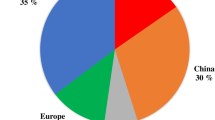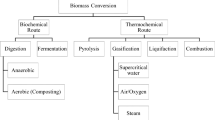Abstract
In this study, the organic Rankine cycle (ORC) is applied to be integrated into the fluid catalytic cracking (FCC) absorption-stabilization system to extract and convert the low-grade process heat to electricity. This newly integrated system is simulated by the Aspen Plus software. For the simulation, eleven different dry and isentropic working fluids are selected to investigate the energy conversion performance of the incorporated ORC system. It is found that, the performance depends highly on the operational parameters, such as mass flow rate and the evaporation pressure of the working fluids, outlet temperature of the process stream. After optimization, the working fluids R124 and R227ea are determined to be the best candidates due to their highest output net work in HCT (high critical temperature) and LCT (low critical temperature) working fluids, respectively. A further optimization has been conducted based on the economic evaluations (i.e., electricity production cost (EPC) and total annual profit (TAP)). Results show that, for the HCT working fluids, the use of working fluid of R245fa allows the EPC to be the lowest, while the application of R124 obtains the highest TAP. For the LCT working fluids, R227ea is the best choice due to its lowest EPC and highest TAP.
Similar content being viewed by others
References
Qiang, W., Yanzhong, L., and Jiang, W, Analysis of PowerCycleBased onColdEnergy of Liquefied Natural Gas and Low-Grade Heat Source, Appl. Therm. Eng., 2004, vol. 24, no. 4, pp. 539–548.
Song, J., Li, Y., Gu, C.-W., and Zhang, L, Thermodynamic Analysis and Performance Optimization of an ORC (Organic Rankine Cycle) System forMultistrand Waste Heat Sources in Petroleum Refining Industry, Energy, 2014, vol. 71, pp. 673–680.
Yamaguchi, H., Zhang, X.R., Fujima, K., Enomoto, M., and Sawada, N, Solar Energy Powered Rankine Cycle Using Supercritical CO2, Appl. Therm. Eng., 2006, vol. 26, nos. 17/18, pp. 2345–2354.
Lolos, P.A. and Rogdakis, E.D., A Kalina Power Cycle Driven by Renewable Energy Sources, Energy, 2009, vol. 34, no. 4, pp. 457–464.
Vijayaraghavan, S. and Goswami, D.Y., ACombinedPower and CoolingCycle Modified to ImproveResource Utilization Efficiency Using a Distillation Stage, Energy, 2006, vol. 31, nos. 8/9, pp. 1177–1196.
Tchanche, B.F., Lambrinos, G., Frangoudakis, A., and Papadakis, G., Low-Grade Heat Conversion into Power UsingOrganic Rankine Cycles—AReview of Various Applications, Renew. Sust. Energy Rev., 2011, vol. 15, no. 8, pp. 3963–3979.
Lecompte, S., Huisseune, H., van den Broek, M., Vanslambrouck, B., and De Paepe, M, Review of Organic Rankine Cycle (ORC) Architectures for Waste Heat Recovery, Renew. Sust. Energy Rev., 2015, vol. 47, pp. 448–461.
Shengjun, Z., Huaixin, W., and Tao, G, Performance Comparison and Parametric Optimization of Subcritical Organic Rankine Cycle (ORC) and Transcritical Power Cycle System for Low-TemperatureGeothermal Power Generation, Appl. Energy, 2011, vol. 88, no. 8, pp. 2740–2754.
Guo, T., Wang, H.X., and Zhang, S.J, Fluids and ParametersOptimization for aNovel Cogeneration System Driven by Low-Temperature Geothermal Sources, Energy, 2011, vol. 36, no. 5, pp. 2639–2649.
El-Emam, R.S. and Dincer, I, Exergy and Exergoeconomic Analyses and Optimization of Geothermal Organic Rankine Cycle, Appl. Therm. Eng., 2013, vol. 59, nos. 1/2, pp. 435–444.
Bruno, J.C., López-Villada, J., Letelier, E., Romera, S., and Coronas, A, Modeling and Optimization of Solar Organic Rankine Cycle Engines for Reverse Osmosis Desalination, Appl. Therm. Eng., 2008, vol. 28, nos. 17/18, pp. 2212–2226.
Mavrou, P., Papadopoulos, A.I., Stijepovic, M.Z., Seferlis, P., Linke, P., and Voutetakis, S, Novel and Conventional Working Fluid Mixtures for Solar Rankine Cycles: Performance Assessment and Multi-Criteria Selection, Appl. Therm. Eng., 2015, vol. 75, pp. 384–396.
Katsanos, C.O., Hountalas, D.T., and Pariotis, E.G, ThermodynamicAnalysis of a Rankine Cycle Applied on a Diesel Truck Engine Using Steam and OrganicMedium, Energy Conv.Manag., 2012, vol. 60, pp. 68–76.
Yang, F., Zhang, H., Song, S., Bei, C., Wang, H., and Wang, E, Thermoeconomic Multi-Objective Optimization of an Organic Rankine Cycle for Exhaust Waste Heat Recovery of a Diesel Engine, Energy, 2015, vol. 93, pp. 2208–2228.
Al-Sulaiman, F.A., Hamdullahpur, F., and Dincer, I, Greenhouse Gas Emission and Exergy Assessments of an Integrated Organic Rankine Cycle with a Biomass Combustor for Combined Cooling, Heating and Power Production, Appl. Therm. Eng., 2011, vol. 31, no. 4, pp. 439–446.
Algieri, A. and Morrone, P, Comparative Energetic Analysis ofHigh-Temperature Subcritical and Transcritical Organic Rankine Cycle (ORC). A Biomass Application in the Sibari District, Appl. Therm. Eng., 2012, vol. 36, pp. 236–244.
Liu, B.-T., Chien, K.-H., and Wang, C.-C., Effect of Working Fluids on Organic Rankine Cycle for Waste Heat Recovery, Energy, 2004, vol. 29, no. 8, pp. 1207–1217.
Eyidogan, M, Canka Kilic, F., Kaya, D., Coban, V., and Cagman, S., Investigation ofOrganic Rankine Cycle (ORC) Technologies in Turkey from the Technical and Economic Point of View, Renew. Sust. Energy Rev., 2016, vol. 58, pp. 885–895.
Yu, H., Feng, X., and Wang, Y, Working Fluid Selection for Organic Rankine Cycle (ORC) Considering the Characteristics ofWaste Heat Sources, Ind. Eng. Chem. Res., 2016, vol. 55, no. 5, pp. 1309–1321.
Jung, H. C., Krumdieck, S., and Vranjes, T, Feasibility Assessment of Refinery Waste Heat-to-Power Conversion Using an Organic Rankine Cycle, Energy Conv. Manag., 2014, vol. 77, pp. 396–407.
Bao, J. and Zhao, L., A Review of Working Fluid and Expand er Selections for Organic Rankine Cycle, Renew. Sust. Energy Rev., 2013, vol. 24, pp. 325–342.
Stijepovic, M.Z., Linke, P., Papadopoulos, A.I., and Grujic, A.S, On the Role ofWorking Fluid Properties in Organic Rankine Cycle Performance, Appl. Therm. Eng., 2012, vol. 36, pp. 406–413.
Wu, Y., Zhu, Y., and Yu, L, Thermal and EconomicPerformance Analysis of ZeotropicMixtures for Organic Rankine Cycles, Appl. Therm. Eng., 2016, vol. 96, pp. 57–63.
Shu, G., Yu, G., Tian, H., Wei, H., and Liang, X., AMulti-Approach Evaluation System (MA-ES) ofOrganic Rankine Cycles (ORC) Used inWaste Heat Utilization, Appl. Energy, 2014, vol. 132, pp. 325–338.
Meinel, D., Wieland, C., and Spliethoff, H, Economic Comparison of ORC (Organic Rankine Cycle) Processes at Different Scales, Energy, 2014, vol. 74, pp. 694–706.
Aghahosseini, S. and Dincer, I, Comparative Performance Analysis of Low-Temperature Organic Rankine Cycle (ORC) Using Pure and ZeotropicWorking Fluids, Appl. Therm. Eng., 2013, vol. 54, no. 1, pp. 35–42.
Li, Y.-R., Wang, J.-N., Du, M.-T., Wu, S.-Y., Liu, C., and Xu, J.-L., Effect of Pinch Point Temperature Difference on Cost-Effective Performance of Organic Rankine Cycle, Int. J. Energy Res., 2013, vol. 37, no. 15, pp. 1952–1962.
Li, Y.-R., Du, M.-T., Wu, C.-M., Wu, S.-Y., Liu, C., and Xu, J.-L., Economical Evaluation and Optimization of Subcritical Organic Rankine Cycle Based on Temperature Matching Analysis, Energy, 2014, vol. 68, pp. 238–247.
Desai, N.B. and Band yopadhyay, S., Thermo-economic Analysis and Selection of Working Fluid for Solar Organic Rankine Cycle, Appl. Therm. Eng., 2016, vol. 95, pp. 471–481.
Quoilin, S., Declaye, S., Tchanche, B.F., and Lemort, V., Thermo-economic Optimization of Waste Heat Recovery Organic Rankine Cycles, Appl. Therm. Eng., 2011, vol. 31, nos. 14/15, pp. 2885–2893.
Walraven, D., Laenen, B., and D’Haeseleer, W, Economic System Optimization of Air-Cooled Organic Rankine Cycles Powered by Low-Temperature Geothermal Heat Sources, Energy, 2015, vol. 80, pp. 104–113.
Barse, K.A. and Mann, M.D, Maximizing ORC Performance with Optimal Match of Working Fluid with System Design, Appl. Therm. Eng., 2016, vol. 100, pp. 11–19.
Feng, Y., Hung, T., Greg, K., Zhang, Y., Li, B., and Yang, J, Thermoeconomic Comparison between Pure and Mixture Working Fluids of Organic Rankine Cycles (ORCs) for Low-Temperature Waste Heat Recovery, Energy Conv. Manag., 2015, vol. 106, pp. 859–872.
Imran, M., Usman, M., Park, B.-S., and Yang, Y, Comparative Assessment of Organic Rankine Cycle Integration for Low-Temperature Geothermal Heat Source Applications, Energy, 2016, vol. 102, pp. 473–490.
Turton, R., Bailie, R.C., Whiting, W.B., and Shaeiwitz, J.A., Analysis, Synthesis and Design of Chemical Processes, New Jersey: Prentice Hall PTR, 1998.
Chacartegui, R., Vigna, L., Becerra, J.A., and Verda, V, Analysis of Two Heat Storage Integrations for an Organic Rankine Cycle Parabolic through Solar Power Plant, Energy Conv. Manag., 2016, vol. 125, pp. 353–367.
Meinel, D., Wieland, C., and Spliethoff, H, Effect and Comparison of Different Working Fluids on a Two- Stage Organic Rankine Cycle (ORC) Concept, Appl. Therm. Eng., 2014, vol. 63, no. 1, pp. 246–253.
Author information
Authors and Affiliations
Corresponding author
Rights and permissions
About this article
Cite this article
Sui, H., Wu, J., He, L. et al. Conversion of low-grade heat from FCC absorption-stabilization system to electricity by organic Rankine cycles: Simulation and optimization. J. Engin. Thermophys. 26, 216–233 (2017). https://doi.org/10.1134/S1810232817020072
Received:
Published:
Issue Date:
DOI: https://doi.org/10.1134/S1810232817020072




